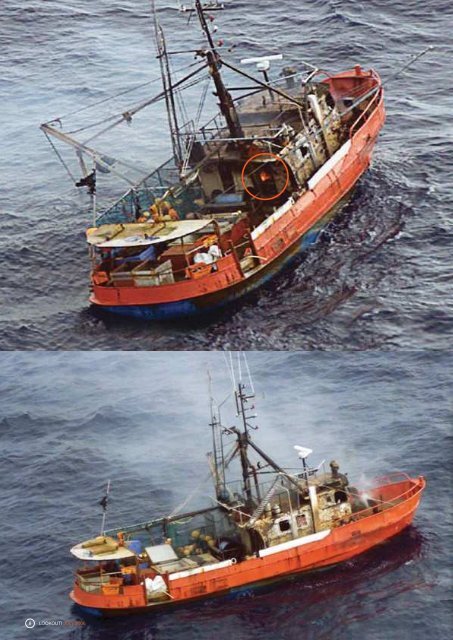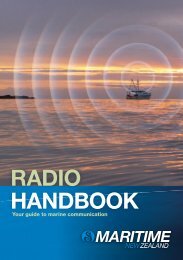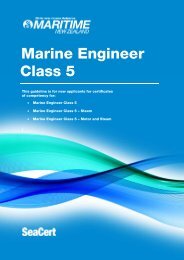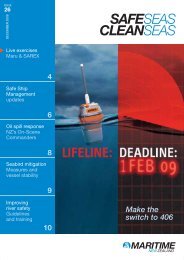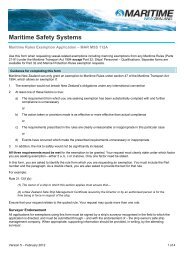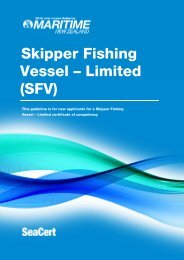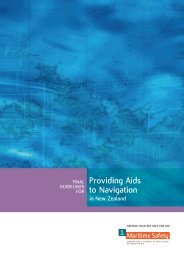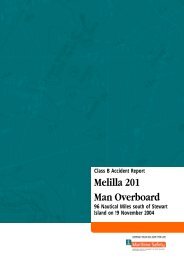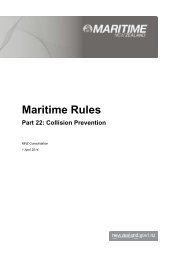Create successful ePaper yourself
Turn your PDF publications into a flip-book with our unique Google optimized e-Paper software.
Fire! But nofixed meansto fight it!He aimed a 9kg CO 2cylinder through thehatch opening but thishad no effect on extinguishingthe fire.A 15 metre long-line tunavessel caught fire95 nautical miles off land.The skipper and two crew were settingup their gear on the fishing grounds whenlight grey smoke was seen coming frombehind the wheelhouse.The skipper immediately reducedspeed and took the main engine out ofgear. Opening the engine room accesshatch from the saloon, he saw flamesand greyish back smoke coming fromthe port side of the engine compartmentat deckhead level. He aimed a 9kg CO 2cylinder through the hatch opening butthis had no effect on extinguishing the fire.The skipper began emergency procedures,alerting the crew to the locationof the fire and calling for the liferaft to bemoved to the after deck, and the tender tobe launched in case it became necessaryto abandon ship. The skipper attemptedleft: The abandoned vessel with fire visiblein the accommodation (circled).to extinguish the fire a second time bytying down the trigger of a 9kg foamextinguisher and throwing this through theengine room hatch in the general directionof where he thought the fire had startedand then closing the hatch again.The skipper then closed all ventilatorsand dogs for the engine roomair intake and exhaust, and shut off thefuel tanks, which combined, containedabout 7 200 litres of marine diesel oil.He returned to the wheelhouse andre-opened the engine hatch but saw theflames had not diminished and closed thehatch again. Meanwhile the crew gatheredsurvival equipment and prepared tolaunch the liferaft.The skipper managed to make threeMayday calls on 2182 MHz and 4125 MHzvia a single sideband radio and to activatethe 406 MHz EPIRB before abandoningship and later an additional 121.5 MHzEPIRB that was kept in the liferaft. Hiscalls were answered by <strong>Maritime</strong> NZ’s<strong>Maritime</strong> Operations Centre.The skipper tried several times toestablish whether the fire was intensifyingor diminishing before being forced toabandon the vessel due to toxic smokeand flames. The steel wheelhouse wasglowing red from the heat and flamescould be seen reaching about 1-2 metresabove the wheelhouse, whose windowswere heard exploding. Once in the liferaftthe skipper fired a distress rocket. By thistime, daylight was fading.The trio watched the vessel burn fromthe liferaft over the following five hoursbefore being located by an RNZAF Orionsearch aircraft and later rescued by arescue helicopter.When salvage vessels arrived at the lastknown position, there was no trace of thevessel, aside from its long-line equipment.View the full report online at:www.maritimenz.govt.nzLookout!Points1. As the wreck of the vessel could not betraced and the crew were unable to accessthe engine room, it was not possibleto determine either the cause of the fire orhow the vessel sank. Intense heat in theengine room would have distorted metaland possibly broken welds. The rupturingand explosion of the two fuel tanks cannotbe discounted with diesel oil havinga flashpoint of 65 degrees centigrade. Allskin fittings in the vessel were metallicand solid steel watertight doors separatedthe engine room from the rest of thevessel. The only access to the engineroom was through the hatch located in thesaloon. The last photographs that weretaken of the vessel by the Orion aircraftshowed substantial fire damage to thewheelhouse with smoke coming from theforward engine compartment vents butwith no visible damage in way of the afterfish hold. There was no obvious list or trimon the vessel, which was still riding highin the water when it was last observed.2. Under <strong>Maritime</strong> Rules, the vessel,being under 24 metres in length, was notrequired to have either a fire detectionsystem or a fixed fire fighting system inthe engine room. An amendment to theRules is currently under considerationby <strong>Maritime</strong> <strong>New</strong> <strong>Zealand</strong>. A fixed firedetection system or a remote powerdriven emergency fire pump would probablyhave saved this vessel. Fire pumpsshould be installed away from machineryspaces and be capable of being drivenindependently of the vessel’s main andauxiliary machinery.3. Throwing fire extinguishers into burningengine rooms is not recommended.Foam has to be aimed at the base of afire to be effective and a foam cylindermust be held upright to operate fully. Afoam extinguisher that has not been fullydischarged has the potential to explodeor rupture.4. The vessel was equipped with atwo-inch fire pump (even though this wasnot required by <strong>Maritime</strong> Rules), but thiswas operated off the main engine andwas rendered inoperable when the mainengine stopped.5. The skipper said he had a robusthazard identification system on boardand conducted drills, including fire drills,every 14 days.6. Given the prevailing calm conditions,it is likely that water initially entered thevessel below the waterline making thevessel sit lower in the water. Entrancesto the accommodation and fish hold thatwere left open would have contributed tothe loss once the deck edge had becomeimmersed. If flooding had been restrictedto the engine room, the vessel wouldprobably have had sufficient reservebuoyancy to remain afloat. LOOKOUT! JULY <strong>2006</strong>LOOKOUT! JULY <strong>2006</strong>


